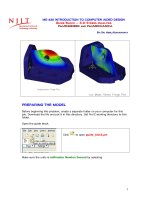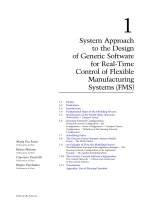Problems and solutionson mechanics docx
Bạn đang xem bản rút gọn của tài liệu. Xem và tải ngay bản đầy đủ của tài liệu tại đây (16.98 MB, 768 trang )
Pro~lems
and
Solutions
on
Mechanics
Major American
Universities
Ph.D.
Qualif~~n~ Questions
and
Solutions
Problems
and
Solutions
on
Mechanics
Co~~il~d
by:
The Physics Coaching
Class
University of Science and
Technology
of
China
Refereed
by:
~iangYuan-qi, Gu En-pu, Cheng
Jia-fu,
ti
Ze-hua,Ylang De-tian
Edited
by:
Lirn
Yung-kuo
World
Scientific
~e~~e~s~ye~offdo~
'Singapore
e~~ng~ong
Pub~j.~he(/
hy
World Scienrific Publishing Co. Pte.
1-td
5
Toh Tuck Link, Singapore 596224
(A'A
@c,e;
Suite 202,
1060
Main
Street, Kivcr
Wge,
NJ
07661
UK
c@j%'r,c:
57
Shelton Street, Covent Garden, London WC2H
9HE
British Library
Catafoguing-in-Publi~tion
Data
A
Latalogue
record
for
this
book
is available
frum
the
British
Library
First published 1994
Reprinted 2001,2002
Major
American
Zlniversities
Ph.D.
Qualifying
Questions
and
Solutions
PROBLEMS
AND
SOLUTIONS
ON
MECHANICS
Copyright
0
1994
by World Scientific Publishing
Co.
Pte. Ltd.
All
rights
reserved.
This book,
or
pctrts
thereof,
muy
not
be reproduced in
uny
form
or
by
uny
meuns,
elel~onic
or
mec~iuiii~~il~ including ph~~t~jc~~py~ng, recording
or
any
inform~fio~t storuge
und
reirievul
sy.ytern
vim'
known
or
to
be
invented,
with~)i~t
wriiren
permission from
the
Publisher.
For
photocopying
of
material in this ,volume, please pay a copying fee through the Copyright
Clearance Center, Inc., 222
Rosewood
Drive, Danvers,
MA
01923,
USA.
In
this case permission to
ph~toeopy
is
not required
from
the publisher.
ISBN
981 -02-1295-X
981-02-1298-4 (pbk)
Printed
in
Singapore.
PREFACE
This series of physics problems and solutions which consists of seven
volumes
-
Mechanics, Electromagnetism, Optics, Atomic, Nuclear and
Particle Physics, Thermodynamics and Statistical Physics, Quantum Me-
chanics, Solid State Physics
-
contains a selection of
2550
problems from
the graduate-school entrance and qualifying examination papers of seven
US. universities
-
California University Berkeley Campus, Columbia Uni-
versity, Chicago University, Massachusetts Institute of Technology,
New
York
State University
Buffalo
Campus, Princeton University, Wisconsin
University
-
as
well
as
the CUSPEA and C.C. Ting’s papers
for
selection
of Chinese students for further studies in U.S.A. and their solutions which
represent the effort of more than
70
Chinese physicists plus some
20
more
who checked the solutions.
The series
is
remarkable for its comprehensive coverage. In each area
the problems span
a
wide spectrum of topics while
many
problems overlap
several areas. The problems themselves are remarkable for their versati-
lity in applying the physical laws and principles, their up-to-date realistic
situations, and their scanty demand on mathematical skills. Many of the
problems involve order-of-magnitude calculations which one often requires
in
an
experimental situation
for
estimating
a
quantity from
a
simple model.
In short, the exercises blend together the objectives of enhancement of one’s
understanding of the physical principles
and
ability of practical application.
The solutions
as
presented generally just provide
a
guidance to solving
the problems, rather than step by step manipulation, and leave much
to
the students to work out for themselves, of whom much is demanded of the
basic knowledge in physics. Thus the series would provide an invaluable
complement to the textbooks.
The present volume for Mechanics which consists of three parts
-
Newtonian Mechanics, Analytical Mechanics, and Special Relativity
-
contains
410
problems.
27
Chinese physicists were involved in the task
of
preparing and checking the
solutions.
V
vi
Preface
In editing, no attempt has been made to
unify
the physical terms, units,
and symbols. Rather
,
they are left to the setters’ and solvers’
own
prefer-
ence
so
as
to reflect the realistic situation
of
the usage today. Great pains
has been taken to trace the logical steps from the first principles to the final
solutions, frequently even to the extent of rewritting the entire solution.
In addition,
a
subject index has been included to facilitate the location
of
topics. These editorial efforts hopefully
will
enhance the value
of
the volume
to the students and teachers alike.
Yung-Kuo Lim
Editor
INTRODUCTION
Solving problems in course work is an exercise of the mental faculties,
and examination problems are usually chosen from,
or
set similar to, such
problems. Working out problems is thus an essential and important aspect
of
the study
of
physics
The series on Problems and Solutions in Physics comprises seven vol-
umes and is the result of months
of
work of
a
number
of
Chinese physicists.
The subjects of the volumes and the respective coordinators are
as
follows:
1.
Mechanics
(Qiang Yuan-qi, Gu En-pu, Cheng Jiefu, Li Ze-hua, Yang
2.
EZectromagnetism
(Zhao Sh-ping, You Jun-han, Zhu Jun-jie)
3.
Optics
(Bai Gui-ru, Guo Guang-can)
4.
Atomic, Nuclear and Particle Physics
(Jin Huai-cheng, Yang Baezhong,
5.
Thermodynamics and Statistical Physics
(Zheng Jiu-ren)
6.
Quantum Mechanics
(Zhang Yong-de, Zhu Dong-pei, Fan Hong-yi)
7.
Solid State Physics and Miscellaneous Topics
(Zhang Jia-lu, Zhou You-
De-tian)
Fm
Yang-mei)
yuan, Zhang Shi-ling)
These volumes, which cover almost all aspects
of
university physics,
contain some
2550
problems solved in detail.
The problems have been carefully chosen from
a
total of
3100
problems
collected from the China-U.S.A. Physics Examination and Application
Programme, the Ph.D. Qualifying Examination on Experimental High
Energy Physics sponsored by Chao-chong Ting,
and
the graduate qualifying
examinations of seven world-renowned American universities: Columbia
University, the University
of
California
at
Berkeley, Massachusetts Institute
of
Technology, the University
of
Wisconsin, the University of Chicago,
Princeton University, and the State University of New York
at
Buffalo.
Generally speaking, examination problems in physics in American uni-
versities do not require too much mathematics. They can be characterized
vii
viii
Introduction
to
a
large extent
as
follows. Many problems are concerned with the
various frontier subjects and overlapping domains of topics, having been
selected from the setters’ own research encounters. These problems show
a
“modern” flavor. Some problems involve
a
wide field and require
a
sharp
mind for their analysis, while others require simple and practical methods
demanding
a
fine “touch of physics.” We believe that these problems,
as
a
whole, reflect to some extent the characteristics of American science and
culture,
as
well
as
give
a
glimpse of the philosophy underlying American
education.
That being
so,
we consider it worthwhile to collect and solve these
problems and introduce them
to
physics students and teachers everywhere,
even though the work is both tedious and strenuous. About
a
hundred
teachers and graduate students took part in this time-consuming task.
This volume on Mechanics which contains
410
problems is divided into
three parts:
Part
I
consists of
272
problems on Newtonian Mechanics;
Part
11,
84
problems on Analytical Mechanics;
Part
111,
54
problems on
Special Relativity.
A small fraction of the problems
is
of the nature of mechanics
as
in
general physics, while the majority properly belongs to theoretical me-
chanics, with some on relativity.
A
wide range of knowledge is required
for
solving some of the problems which demand
a
good understanding
of electromagnetism, optics, particle physics, mathematical physics, etc.
We consider such problems particularly beneficial to the student
as
they
show the interrelationship of different areas
of
physics which one is likely
to encounter in later life. Twenty seven physicists contributed to this
volume, notably Ma Qian-cheng, Deng You-ping, Yang Zhong-xia, Ji Shu,
Yang De-tian, Wang Ping, Li Xiao-ping, Qiang Yuan-qi, Chen Wei-zu,
Hou
Bi-hui, and Chm Ze-xian.
7
August
1991
CONTENTS
Preface
Introduction
Part
I
Newtonian Mechanics
1.
Dynamics
of
a Point
Mass
(1001-1108)
2. Dynamics of a System of Point
Masses
(1109-1144)
3. Dynamics of Rigid Bodies (1145-1223)
4. Dynamics of Deformable Bodies (1224-1272)
Part
I1
Analytical Mechanics
1.
Lagrange’s Equations (2001-2027)
2.
Small
Oscillations (2028-2067)
3.
Hamilton’s Canonical Equations 12068-2084)
Part
I11 Special Relativity
Special Relativity (3001- 3054)
V
vii
1
3
185
237
367
459
46
1
521
619
657
659
Index
to
Problems
751
PART
I
NEWTONIAN MECHANICS
DYNAMICS
OF
A
POINT
MASS
(1001-1108)
1001
A
man of weight
w
is in an elevator of weight
w.
The elevator accelerates
(a) What is the apparent weight
of
the man?
(b) The man climbs
a
vertical ladder within the elevator at
a
speed
v
relative to the elevator. What is the man’s rate
of
expenditure
of
energy
(power output)?
(
Wisconsin)
Solution:
vertically up
at
a
rate
a
and at
a
certain instant has
a
speed
V.
(a)
The apparent weight
of
the man is
20
F=wf-a=w
9
g
being the acceleration
of
gravity.
(b) The man’s rate
of
expenditure of energy
is
1002
An
orbiting space station is observed to remain always vertically above
the same point on the earth. Where on earth
is
the observer? Describe the
orbit of the space station
as
completely
as
possible.
(
Wisconsin)
Solution:
The observer must be on the equator of the earth. The orbit
of
the
space station is
a
large circle in the equatorial plane with center
at
the
center of the earth. The radius of the orbit can be figured out using the
orbiting period of
24
hours*
as
follows. Let the radius
of
the orbit be
R
and
that
of
the earth be
&.
*For
a
more accurate calculation, the orbiting period should be taken
as
23
hours
56
minutes and
4
seconds.
3
4
Problems
€4
Solutions
on
Mechanics
We have
mu2 GMm
R
R2
’
where
v
is the speed
of
the space station,
G
is the universal constant
of
gravitation,
m
and
M
are the masses of the space station and the earth
-=-
respectively, giving
As
GM
02
=
-
R‘
GMm
mg=-,
%
we have
GM=Gg.
Hence
2
-
v
R
For
circular motion with constant speed
v,
the orbiting period
is
2xR
T=
21
Hence
and
4x2R2
-
gg
T2
R
=
4.2 x
lo4
km
%T2g
R=
(7)
1003
In
an
amusement park there is
a
rotating horizontal disk.
A
child can
sit on it
at
any radius (Fig.
1.1).
As
the disk begins to “speed
up”,
the
child may slide
off
if the frictional force is insufficient. The mass of the
child is
50
kg and the coefficient
of
friction is
0.4.
The angular velocity is
2
rad/s.
What is the maximum radius
R
where he can sit and still remain
on the disk?
(
WZsconsZn
)
Newtonian
Mechanics
5
Solution:
Under the critical circumstance that the child just starts to slide,
mk2
=
pmg
,
Hence
As
the centrifugal force is proportional to the radius, this is the maximum
radius for no-sliding.
Fig.
1.1.
1004
A
cord passing
over
a frictionless pulley has
a
9
kg mass tied on one end
and
a
7
kg
mass
on the other end
(Fig.
1.2).
Determine the acceleration
and the tension of the cord.
(
Wisconsin)
Solution:
Neglecting the moment of inertia of the pulley, we obtain the equations
of
motion
mlx
=
mlg
-
F
and
m2P
=
F
-
m2g
.
6
Problems
d
Solutions
on
Mechanics
Hence the tension
of
the cord and the acceleration are respectively
and
(m1
-m2)g
-
-
29
2=
-
rnl+mz 16
=
1.225
m/s2
.
X
I*
mlg
m2
9
Fig.
1.2.
1005
A
brick is given an initial speed of
5
ft/s
up an inclined plane at an angle
of
30"
from
the horizontal. The coefficient
of
(sliding
or
static) friction is
p
=
a/12.
After
0.5
s,
how
far
is
the brick
from
its original position?
You
may
take
g
=
32
ft/s2.
(
Wisconsin
)
Solution:
Choose Cartesian coordinates
as
shown
in Fig.
1.3.
For
x
>
0,
the
equation
of
the motion
of
the brick
is
mx
=
-mgsintl
-
pmgcostl
,
giving
Newtonaan
Mechanics
7
Fig.
1.3.
59
8
5
=
-g(sinO+pcosO)
=
.
The time of upward motion of the brick is then
50
ti
=
-
=
5/(5g/8)
=
0.25
s
-X
and the displacement of the brick
is
For
t
>
tl,
x
<
0
and the equation of motion becomes
mx
=
-mg sin
0
+
pmg cos
0
or
39
Z
=
-g(sinO
-
pcos0)
=
.
8
The displacement during the time interval
tl
=
0.25
s
to
t2
=
0.5
s
is
so
that the displacement of the brick at
t
=
0.5
s
is
5’
51
+
AX
=
518
-
318
=
0.25
ft.
1006
A
person of mass
80
kg
jumps from a height of
1
meter and foolishly
forgets to buckle his knees
as
he lands. His body decelerates over a distance
of only one cm. Calculate the total force on his legs during deceleration.
(
Wisconsin)
8
Problems
&
Solutions
on
Mechanics
Solution:
The person has mechanical energy
El
=
mg(h
+
s)
just before he lands.
The work done by him during deceleration is
E2
=
fs,
where
f
is the total
force on his
legs.
As
El
=
E2,
mgh
80
x
1
f=-
S
4-
mg
=
(0.01
+
80)
g
=
80809
N
1007
A
mas
M
slides without friction
on
the roller coaster track shown in
Fig.
1.4.
The curved sections of the track have radius of curvature
R.
The
mass
begins its descent from the height
h.
At
some value of
h,
the mass
will begin to lose contact with the track. Indicate on the diagram where
the mass loses contact with the track and calculate the minimum value
of
h
for which this happens.
(
Wisconsin
)
30°
Fig.
1.4.
Solution:
Before the inflection point
A
of
the track, the normal reaction
of
the
track on the mass,
N,
is
mu2
R
N=-
+mgsinB
where
v
is the velocity of the mass. After the inflection point,
mu2
N
+
=
mgsinfl
for which
sin
0
=
&
,
or
8
=
30".
Newtonian Mechanics
9
The
mass
loses contact with the track
if
N
5
0.
This can only happen
for the second part of the track and only
if
mu2
-
2
mgsin8.
R
The conservation of mechanical energy
1
mg[h
-
(R
-
Rsine)]
=
;;mu2
then requires
R sin
8
h
-
R
+
Rsin8
2
-
2,
or
R sin
8
h>R
2.
The earliest the
mass
can
start
to
lose
contact with the track
is
at
A
for
which
0
=
30".
Hence the minimum
h
required is
y.
1008
Consider
a
rotating spherical planet. The velocity of
a
point on
its
equator
is
V.
The effect of rotation of the planet is to make
g
at the equator
112
of
g
at the pole. What
is
the escape velocity
for
a
polar particle on the
planet expressed
as
a
multiple of
V?
(Wisconsin)
Solution:
Let
g
and
g'
be the gravitational accelerations at the pole
and
at the
equator respectively and consider
a
body of mass
m
on the surface
of
the
planet, which
has
a
mass
M.
At the pole,
GMm
mg=
-
R2
'
giving
GM
=
gR2
.
At the equator, we have
mV2 GMm
,
mg mg
mg =mg =-
R
R2
2 2
10
Problems
€4
Solutions
on
Mechanics
Hence
g
=
2V2/R.
infinity from the planet, the body will have potential energy
If
we define gravitational potential energy with respect to a point at
GMm
dr
=
GMm
-1,
-7-
R'
Note that the negative sign in front
of
the gravitational force takes account
of its attractiveness. The body at the pole then has total energy
For
it to escape from the planet, its total energy must be at least equal
to the minimum energy of
a
body at infinity, i.e. zero. Hence the escape
or
=
2gR
=
4V2
,
2GM
v2
=
-
R
i.e.
v=2v.
1009
A
small mass
m
rests
at
the edge of
a
horizontal disk of radius
R;
the
coefficient
of
static friction between the
mass
and the disk
is
p.
The disk is
rotated about its axis at
an
angular velocity such that the mass slides
off
the disk and lands on the
floor
h
meters below. What was its horizontal
distance of travel from the point that it left the disk?
(
Wisconsin)
Solution:
The maximum static friction between the mass and the disk is
f
=
pmg.
When the small mass slides
off
the disk, its horizontal velocity
21
is given
bY
mu2
-
=
pmg
.
R
Thus
v=m.
Newtonian
Mechanics
11
The time required to descend
a
distance
h
from rest is
t=e.
Therefore the horizontal distance of travel before landing on the
floor
is
equal to
vt
=
Jm.
1010
A
marble bounces down stairs in
a
regular manner, hitting each step
at
the same place and bouncing the same height above each step (Fig.
1.5).
The stair height equals its depth (tread=rise) and the coefficient of resti-
tution
e
is given. Find the necessary horizontal velocity and bounce height
(the coefficient
of
restitution
is
defined
as
e
=
-vf/vi,
where
vf
and
vi
are
the vertical velocities just after and before the bounce respectively).
(
Wisconsin)
Fig.
1.5.
Solution:
Use unit vectors
i,
j
as
shown in Fig.
1.5
and let the horizontal velocity
of
the marble be
Vh.
The velocities just before and after
a
bounce are
respectively
12
Problems
d
Solutions
on
Mechanics
v1
=
vhi
+
vij
v2
=
vhi
+
vfj
.
As
the conditions
at
each step remain exactly the same,
ui,vf
and
vh
are
all
constant. The conservation
of
mechanical energy
and
1
12
-mu:
=
-mu2
+
mgl
2
2
gives
7J;
=
"f
2
+
291
.
As
by definition
vf
=
-eui
,
the above gives
v2=-*
291
'
1-e2
The time required for each bounce
is
va
-?If
1
t= =-,
9
vh
giving
gll-e
-
91
'ui
-
vf
q&=
(1
+
e)ui
which
is
the necessary horizontal velocity. The bouncing height
H
is given
by the conservation of mechanical energy
1011
Assume
all
surfaces to
be
frictionless and the inertia of pulley and cord
negligible (Fig.
1.6).
Find the horizontal force necessary to prevent
any
relative motion of
ml,
m2
and
M.
(
Wisconsin
)
Newtonian
Mechanics
13
Fig.
1.6.
Solution:
The forces
fi,
F
and
mg
are shown in Fig.
1.7.
The accelerations
of
ml,
m2
and
M
are the
same
when there
is
no
relative motion among them.
The equations
of
motion
along
the
z-axis
are
(M+rnl
+rnz)Z=F,
mix=
fi
.
As
there is no relative motion
of
m2
along the
y-axis,
fl
=
m29
.
Combining these equations, we obtain
Fig.
1.7.
1012
The sun is about
25,000
light years from the center
of
the galaxy and
travels approximately in
a
circle with
a
period
of
170,000,000
years. The
earth
is
8
light
minutes
from
the sun.
From
these data alone, find the
14
Problems
€4
Solutions on Mechanics
approximate gravitational mass of the galaxy in units of the sun's mass. You
may assume that the gravitational force on the sun may be approximated
by assuming that all the
mass
of the galaxy
is
at
its
center.
(
Wisconsin
)
Solution:
For
the motion of the earth around the sun,
mu2
-
Gmm,
-~
-
r r2
'
where
T
is the distance from the earth to the sun,
v
is
the velocity of the
earth,
m
and
m,
are the maSses of the earth and the sun respectively.
For
the motion of the sun around the center
of
the galaxy,
where
R
is the distance from the sun to the center of the galaxy,
V
is the
velocity of the sun and
M
is the mass of the galaxy.
Hence
M=-
Using
V
=
2rR/T,
v
=
2rr/t,
where
T
and
t
are the periods of revolution
of
the sun and the earth respectively, we have
With the data given, we obtain
M
=
1.53
x
101lm,
.
1013
An Olympic diver of mass
m
begins his descent from
a
10
meter high
diving board with
zero
initial velocity.
(a) Calculate the velocity
Vo
on impact with the water and the appre
ximate elapsed time from dive until impact (use any method you choose).
Assume that the buoyant force of the water balances the gravitational
force on the diver and that the viscous force on the diver is
h2.
Newtonian
Mechanics
15
(b)
Set up the equation
of
motion for vertical descent of the diver
through the water.
Solve for the velocity
V
as
a function of the depth
x under water and impose the boundary condition
V
=
VO
at
x
=
0.
(c)
If
b/m
=
0.4
mu', estimate the depth at which
V
=
Vo/lO.
(d) Solve for the vertical depth x(t)
of
the diver under water in terms
(
Wisconsin)
of
the time under water.
Solution:
=
&
=
d2
x
9.8
x
10
=
14
m/s
.
The time elapsed from dive to impact is
(b)
AS
the gravitational force
on
the diver
is
balanced by the buoyancy,
the equation
of
motion
of
the diver through the water
is
or,
using
x
=
xdx/dx,
dx
b
_-
-
dx.
x
m
Integrating, with
x
=
VO
at
x
=
0,
we obtain
v
x
=
voe-A;"
.
(c) When
V
=
V,/lO,
m
In
10
b
0.4
x=-lnlO=
-
5.76
m
.
(d)
As
dx/dt
=
&e-2x,
eAxdx
=
Vodt
.
Integrating, with x
=
0
at
t
=
0,
we obtain
or









